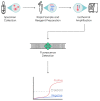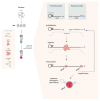Aptamers-Diagnostic and Therapeutic Solution in SARS-CoV-2
- PMID: 35163338
- PMCID: PMC8836149
- DOI: 10.3390/ijms23031412
Aptamers-Diagnostic and Therapeutic Solution in SARS-CoV-2
Abstract
The SARS-CoV-2 virus is currently the most serious challenge to global public health. Its emergence has severely disrupted the functioning of health services and the economic and social situation worldwide. Therefore, new diagnostic and therapeutic tools are urgently needed to allow for the early detection of the SARS-CoV-2 virus and appropriate treatment, which is crucial for the effective control of the COVID-19 disease. The ideal solution seems to be the use of aptamers-short fragments of nucleic acids, DNA or RNA-that can bind selected proteins with high specificity and affinity. They can be used in methods that base the reading of the test result on fluorescence phenomena, chemiluminescence, and electrochemical changes. Exploiting the properties of aptamers will enable the introduction of rapid, sensitive, specific, and low-cost tests for the routine diagnosis of SARS-CoV-2. Aptamers are excellent candidates for the development of point-of-care diagnostic devices and are potential therapeutic tools for the treatment of COVID-19. They can effectively block coronavirus activity in multiple fields by binding viral proteins and acting as carriers of therapeutic substances. In this review, we present recent developments in the design of various types of aptasensors to detect and treat the SARS-CoV-2 infection.
Keywords: COVID-19; SARS-CoV; aptamers; aptasensors.
Conflict of interest statement
The authors declare no conflict of interest.
Figures





Similar articles
-
The Latest Achievements in the Construction of Influenza Virus Detection Aptasensors.Viruses. 2020 Nov 30;12(12):1365. doi: 10.3390/v12121365. Viruses. 2020. PMID: 33265901 Free PMC article. Review.
-
Rapid COVID-19 testing: Speed, quality and cost. Can you have all three?Clin Biochem. 2021 Sep;95:13-14. doi: 10.1016/j.clinbiochem.2021.05.009. Epub 2021 May 26. Clin Biochem. 2021. PMID: 34048775 Free PMC article.
-
Rapid diagnostics for SARS-CoV-2 virus: point-of-care testing and lessons learned during the pandemic.Bioanalysis. 2021 Aug;13(15):1165-1167. doi: 10.4155/bio-2021-0100. Epub 2021 Jul 21. Bioanalysis. 2021. PMID: 34286599 Free PMC article. No abstract available.
-
DNA aptamer selection for SARS-CoV-2 spike glycoprotein detection.Anal Biochem. 2022 May 15;645:114633. doi: 10.1016/j.ab.2022.114633. Epub 2022 Mar 2. Anal Biochem. 2022. PMID: 35247355 Free PMC article.
-
Diagnostic accuracy of the Cepheid Xpert Xpress and the Abbott ID NOW assay for rapid detection of SARS-CoV-2: A systematic review and meta-analysis.J Med Virol. 2021 Jul;93(7):4523-4531. doi: 10.1002/jmv.26994. Epub 2021 May 3. J Med Virol. 2021. PMID: 33913533 Free PMC article.
Cited by
-
Aptamer-Mediated Electrochemical Detection of SARS-CoV-2 Nucleocapsid Protein in Saliva.Biosensors (Basel). 2024 Sep 30;14(10):471. doi: 10.3390/bios14100471. Biosensors (Basel). 2024. PMID: 39451684 Free PMC article.
-
Advances in Aptamers-Based Applications in Breast Cancer: Drug Delivery, Therapeutics, and Diagnostics.Int J Mol Sci. 2022 Nov 21;23(22):14475. doi: 10.3390/ijms232214475. Int J Mol Sci. 2022. PMID: 36430951 Free PMC article. Review.
-
Comparative analysis of aptamers binding to SARS-CoV-2 N protein using capillary electrophoresis and bio-layer interferometry.Anal Bioanal Chem. 2024 Mar;416(7):1697-1705. doi: 10.1007/s00216-024-05174-3. Epub 2024 Feb 2. Anal Bioanal Chem. 2024. PMID: 38305861
-
SELEX based aptamers with diagnostic and entry inhibitor therapeutic potential for SARS-CoV-2.Sci Rep. 2023 Sep 4;13(1):14560. doi: 10.1038/s41598-023-41885-w. Sci Rep. 2023. PMID: 37666993 Free PMC article.
-
A Multi-Faceted Binding Assessment of Aptamers Targeting the SARS-CoV-2 Spike Protein.Int J Mol Sci. 2024 Apr 24;25(9):4642. doi: 10.3390/ijms25094642. Int J Mol Sci. 2024. PMID: 38731860 Free PMC article.
References
-
- Chan J.F.-W., Yuan S., Kok K.-H., To K.K.-W., Chu H., Yang J., Xing F., Liu J., Yip C.C.-Y., Poon R.W.-S., et al. A familial cluster of pneumonia associated with the 2019 novel coronavirus indicating person-to-person transmission: A study of a family cluster. Lancet. 2020;395:514–523. doi: 10.1016/S0140-6736(20)30154-9. - DOI - PMC - PubMed
-
- World Health Organization Coronavirus Disease (COVID-19) Pandemic. [(accessed on 21 April 2020)]. Available online: https://www.who.int/emergencies/diseases/novel-coronavirus-2019.
-
- Gorbalenya A.E., Baker S.C., Baric R.S., de Groot R.J., Drosten C., Gulyaeva A.A., Haagmans B.L., Lauber C., Leontovich A.M., Neuman B.W., et al. The species severe acute respiratory syndrome-related coronavirus: Classifying 2019-nCoV and naming it SARS-CoV-2. Nat. Microbiol. 2020;5:536–544. doi: 10.1038/s41564-020-0695-z. - DOI - PMC - PubMed
-
- World Health Organization Virtual Press Conference on COVID-19, 11 March 2020. [(accessed on 11 March 2020)]. Available online: https://www.who.int/docs/default-source/%0Acoronaviruse/transcripts/who-....
Publication types
MeSH terms
Substances
LinkOut - more resources
Full Text Sources
Medical
Miscellaneous

